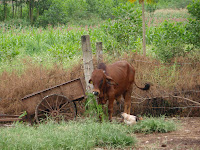 The small cardboard brochure that arrived in the mail belied the spectacle that awaited me in Hanoi, Vietnam, at the 13th AAAP conference. It gathered together 1240 delegates from 36 countries and the aims were sweeping- to increase the quality of life of poor people in rural areas, and to discuss ways to reduce the disadvantage of smallholder farmers in a global economy.
The small cardboard brochure that arrived in the mail belied the spectacle that awaited me in Hanoi, Vietnam, at the 13th AAAP conference. It gathered together 1240 delegates from 36 countries and the aims were sweeping- to increase the quality of life of poor people in rural areas, and to discuss ways to reduce the disadvantage of smallholder farmers in a global economy.The opening ceremony for the Asian – Australasian Association of Animal Production Conference, inside the soaring National Convention Centre (where APEC 2006 was held- there was even a fetching picture of John Howard in national dress on the wall), was a spectacle complete with a military band, endless floral displays, and the most enormous conference banner I have ever seen. It was a far cry from the daily lives of the people that this conference would aim to help; many smallholder farmers live on less than $2 a day.

At the ceremony, the Vietnamese Minister for Agriculture and Rural Development described the plan for Vietnam to be “industrialised by 2020”. Surely there is a hint of irony in discussing this at such a conference: What happens to the traditional smallholder farmer when he is squeezed out of the supply chain under pressure to maximise efficiency and intensify production? It is a tricky question. One cannot deny the rights of poor farmers to improved education, health and security in terms of producing enough food to live on year-round, but shouldn’t we also be aiming to preserve the culture and traditional ways of life of smallholder farmers, rather than trying to turn their farms into intensive piggeries or sterile sheds full of poultry?
Fortunately, many of the scientists at this conference are presenting interesting and inspiring research that can realistically be implemented to improve the lives of smallholder farmers without resorting to intensive non-traditional agriculture. Professor Peter Wynn (now at CSU, Australia) presented on the effects of pre- and post-natal nutrition on cow and buffalo calves, with some simple ideas to improve the growth and life-long productivity of these animals, and Dr Jean Charles Maillard (CIRAD, France) spoke about the need to preserve traditional breeds of production animal, which can be a reservoir of genetic diversity and are often more disease resistant than intensively produced breeds.
Environmental issues such as global warming and the decreasing supply of fossil fuels were not ignored, and several presenters touched on methods that can increase production or reduce greenhouse gas emissions by utilising agricultural waste. Dr Thomas Preston (Columbia) spoke about the use of a gasifier to generate electricity on small farms in Columbia (these simple machines can be fuelled by crop byproducts such as coconut shells), and Dr R.A. Leng (Australia) advocated the use of combined systems, such as farming rice with ducks to weed the paddies as a simple alternative to herbicides, and the use of grazing cattle between palm plants to increase palm oil production.
This conference has shown us many examples of this ‘back to the future’ approach, where all waste is utilised and everything is regarded as a resource. We can only hope that the recommendations from this kind of research will be implemented, as this may be the only way to ensure that smallholder farms remain viable in our increasing globalised world.
Photograph top: Red Sahiwal calf and chicken, Vietnam
Photograph bottom: Part of the foyer of the National Convention Centre, Hanoi



No comments:
Post a Comment